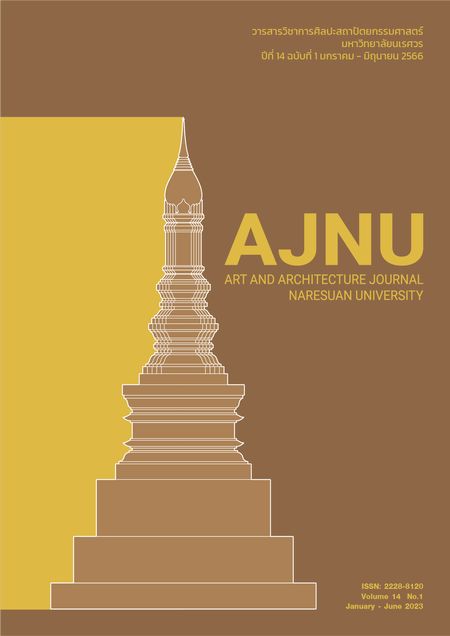The Development of Dry Forming Compressed Lotus Stalk for Craft Products. The Development of Dry Forming Compressed Lotus Stalk for Craft Products.
Main Article Content
Abstract
The objectives of this research were 1) to response to the royal initiative of the plant genetic conservation project under the Royal Initiative of Her Royal Highness Princess Maha Chakri Sirindhorn (RSPG) 2) the general information of Lotus Stalk 3) to test its physical properties of Lotus Stalk 4) to design and produce craft products from dry forming compressed lotus stalk, 5) and to survey the consumers’ satisfaction toward the craft products. The methodology included the following steps.first,study the general characteristics of lotus stalk.Development of lotus stalks by using the lotus stalk to soften them with glycerin at a ratio of 1:3 for 3days.crushed lotus stalk was mixed with glue and urea unformaldehyde glue as per the nine formulas that had been set. The mixture was then compressed in the compression molding machine at 100 degree celsius for 2 minutes, and then cooled for 2 minutes. After that, the molded plates were removed from the machine and kept at room temperature for 7 days. Next, the plates were cut into pieces for physical properties tests, including Modulus of Rupture (MOR), tensile strength, The best lotus stalk plates were then used for forming compressed craft products. For the consumer satisfaction survey, a questionnaire was administered to 120 respondents in Bangkok methopolitan Region.The results showed that The lotus stalk has an average size Diameter of the sectional width 1.33 cm. Length 90 cm. It was found that the mixing ratio of the ninth formula resulted in the following physical properties: Modulus of Rupture (MOR) = 7.29 MPa, tensile strength(dry) 337.63 newton,Elongation was 0.87. These were promising features for forming compressed lotus products for making crafts. In regard to the consumers’ satisfaction, it was found the most consumers were highly satisfied with the products with an average mean score of 4.86.
Article Details

This work is licensed under a Creative Commons Attribution-NonCommercial-NoDerivatives 4.0 International License.
References
ก้านบัวหลวงสู่อุตสาหกรรมสิ่งทอ, (ออนไลน์), สืบค้นจาก: http:// www. doa.go.th › pibai
ตุลาคม 2561).
กิจชัย จิตขจรวานิช, 2550. “กาว,” วารสารวิชาการ, คณะสถาปัตยกรรมศาสตร์ มหาวิทยาลัยศิลปกร,
การออกแบบผลิตภัณฑ์, (ออนไลน์), ม.ป.ป. , สืบค้นจาก http//www.netra.lpru.ac.th/weta/ch2 (5 พฤษภาคม 2562).
การประเมินผล, วิกีพีเดีย สารานุกรมเสรี, (ออนไลน์), 9 มีนาคม 2556, สืบค้นจาก:
http://www.wikipedia.org, (30 มีนาคม2562).
ดรรชนี พัทธวรากร, 2556 “เทคโนโลยีกระบวนการผลิตผลิตภัณฑ์พอลิเมอร์,” เอกสารประกอบการ
สอน, ภาควิชาเคมีอุตสาหกรรม, คณะวิทยาศาสตร์, มหาวิทยาลัยเชียงใหม่..
ธนาวดี ลี้จากภัย, “กาวกับการเลือกใช้งาน,” บทความงานวิจัย, ศูนย์เทคโนโลยี
โลหะและวัสดุศาสตร์แห่งชาติ, (ออนไลน์), ปีที่ 2551. สืบค้นจาก:http://www.vcharkarn.
com/varticle/38229 (30 มีนาคม 2559).
พิพิธภัณฑ์ธรรมศาสตร์เฉลิมพระเกียรติ, เครื่องจักสานในประเทศไทย, (ออนไลน์)มปป, เข้าถึงได้
จาก: http://museum.socanth.tu.ac.th/6_contact.html, (24 กันยายน 2559).
ภานิดา ชัยปัญญา, “การวัดผลความพึงพอใจ,” (ออนไลน์), 2541, สืบค้นจาก:
maitree3.dlogspot.com (15 เมษายน 2558).
มานะ อินพรมมี,2555 “การออกแบบพัฒนาผลิตภัณฑ์ของฝาก ของที่ระลึกผลิตภัณฑ์ชุมชนในจังหวัด เพชรบูรณ์,” งานการวิจัย, มหาวิทยาลัยราชภัฏเพชรบูรณ์.
มาตรฐานกรมโยธาธิการและผังเมือง(1), มยผ. 1224-51, (ออนไลน์), สืบค้นจาก: http://eservices
dpt.go.th/eservice_5/standard/data/sdw/1221_7.pdf (29 เมษายน 2562).
มาตรฐานผลิตภัณฑ์อุตสาหกรรม, มอก. 876-2547, (ออนไลน์), สืบค้นจาก:http://www.fio.co.th/p/tisi _fio/fulltext/TIS876-2547.pdf (20 พฤษภาคม 2558).
มาตรฐานกรมโยธาธิการและผังเมือง(2), มยผ. 1224-51 , (ออนไลน์), สืบค้นจาก: http://eservices.dpt.go.th/eservice_5/standard/data/sdw/1221_7.pdf (29 เมษายน 2562).
นชานนท์ บุนนท์, “วัสดุปะสานและสวนผสมที่เหมาะสมสำหรับการอัดขึ้นรูปถ่านไม้,”
รายงานวิจัย, มหาวิทยาลัยเทคโนโลยีราชมงคลอีสาน นครราชสีมา, 2552.
ผกามาศ ชูสิทธิ์, ภาณุเดช ขัดเงางาม และ เกษมชัย บุญเพ็ญ, “การผลิตแผ่นผนังภายในอาคารที่ทำ จากวัสดุเหลือทิ้งจากต้นสบู่ดำ,” งานวิจัยสนับสนุนจากงบประมาณประจำปี 2555,
มหาวิทยาลัยเทคโนโลยีราชมงคลพระนคร, 2556.
ปราโมทย์ วีรานุกูล, จักรวัฒน์ เรื่องแรงสกูล, สัจจะชาญ พรัดมะลิ และ ประชุม คำพุฒ , 2554. “การใช้กากมะพร้าว ต้นข้าวโพดและเปลือกทุเรียนเป็นวัสดุประกอบชีวภาพทดแทนไม้ใน แผ่นใยอัดความหนาแน่นปานกลาง,” งานวิจัยสนับสนุนจากงบประมาณประจำปี 2554, มหาวิทยาลัยเทคโนโลยีราชมงคลพระนคร.
วาสนา เจริญวิเชียรฉาย,2552 “การออกแบบผลิตภัณฑ์ของตกแต่งบ้านจากวัสดุเหลือใช้ ,” คณะศิลปกรรมศาสตร์, มหาวิทยาลัยเทคโนโลยีราชมงคลธัญบุรี, ปทุมธานี.
เศรษฐมันตร์ กาญจนกุล.2552. บัวบานในงานศิลป์. กรุงเทพฯ : เศรษฐศิลป์.
สถานภาพเศษวัสดุเหลือใช้ทางการเกษตร, 2554. โครงการศึกษาแนวทางบริหารจัดการเศษวัสดุเหลือ ใช้ ทางการเกษตรเพื่อใช้เป็นเชื้อเพลิงและลดการเกิดหมอกควัน, (ออนไลน์), สำนักงานคณะกรรมการวิจัยแห่งชาติ, สืบค้นจาก: http://webkc.dede.go.th/ webmax ( 23 มีนาคม 2558).
สุภางค์ จันทวานิช, “การวิเคราะห์ข้องมูลในการวิจัยเชิงคุณภาพ,” พิมพ์ครั้งที่ 20 กรุงเทพฯ:
สำนักพิมพ์แห่งจุฬาลงกรณ์มหาวิทยาลัย, 2553.
สุภา จุฬคุปต์และคณะ,2553.การพัฒนากระดาษใบบัวอัดแห้งสำหรับใช้ในงานประดิษฐ์.งานวิจัยสนับสนุนจากงบประมาณประจำปี 2553, คณะเทคโนโลยีคหกรรมศาสตร์,มหาวิทยาลัยเทคโนโลยีราชมงคลธัญบุรี.
สุวัฒน์ สิงห์เทพ.2557.การพัฒนาเชือกผักบุ้งสำหรับผลิตภัณฑ์งานประดิษฐ์.วิทยานิพนธ์ปริญญามหาบัณฑิต.คณะเทคโนโลยีคหกรรมศาสตร์,มหาวิทยาลัยเทคโนโลยีราชมงคลธัญบุรี
ส่วนประกอบของวัสดุประสาน, (ออนไลน์), ม.ป.ป., สืบค้นจาก: http//:bangkblznews.com, (2 เมษายน 2562).
สำนักงานมาตรฐานผลิตภัณฑ์อุตสาหกรรม.กระทรวงอุตสาหกรรม,มาตรฐานผลิตภัณฑ์ชุมชน ผลิตภัณฑ์จักสานหวาย(มผช.๑๙/๒๕๔๖) tcps.tisi.go.th(online) 25 มีนาคม 2562
สำนักงานมาตรฐานผลิตภัณฑ์อุตสาหกรรม.กระทรวงอุตสาหกรรม,มาตรฐานผลิตภัณฑ์ชุมชน ผลิตภัณฑ์ตกแต่งหรือหุ้มด้วยถักสานจากพืช(มผช.๑๙๐/๒๕๕๙) tcps.tisi.go.th(online) 25 มีนาคม 2562
สำนักงานมาตรฐานผลิตภัณฑ์อุตสาหกรรม.กระทรวงอุตสาหกรรม,มาตรฐานผลิตภัณฑ์ชุมชน ผลิตภัณฑ์แผ่นพืชอัด(มผช.๑๒๙๒/๒๕๔๙) tcps.tisi.go.th(online) 25 มีนาคม 2562
หลักการออกแบบผลิตภัณฑ์, (ออนไลน์), ม.ป.ป. , สืบค้นจาก: http:www.gotoknow.org/posts/417795 (25 มิถุนายน 2562).
อรรถพล ตะเระ,2551.“คุณสมบัติและการทดสอบวัสดุ,” ภาควิชาเทคโนโลยีวัสดุ, คณะวิทยาศาสตร์,มหาวิทยาลัยรามคำแหง.
W.D. Schindler and P.J. Hauser ,‘softening finishes’, Chemical finishing of textiles.Bhuiyan M.A.R. and Hoque M.Z. 2010. Free radical scavenging activities of Zizyphusmauritiana. Electronic Journal of Environmental, Agricultural and Food Chemistry. 9(1):199-206.
Carpes S.T., Mouráo G.B. and Masson M.L. 2009.Chemical composition and free radical scavenging activity of Apismellifera bee pollen from Southern Brazil.Brazilian Journal of Food Technology. 12(3):220-229.
Kumar G.S., Jayaveera K.N., Ashok Kumar C.K., et al. 2007. Antimicrobial effects of Indian medicinal plants against acne-inducing bacteria.Tropical Journal of Pharmaceutical Research. 6(2):717-723.


